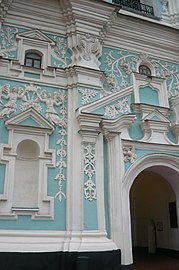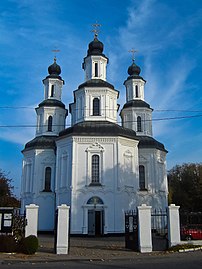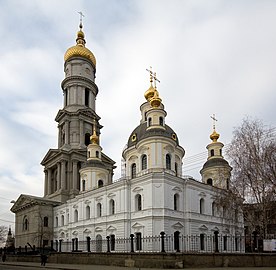You can help expand this article with text translated from the corresponding article in Ukrainian. (September 2013) Click for important translation instructions.
|

Ukrainian Baroque (Ukrainian: Українське бароко), also known as Cossack Baroque (Ukrainian: Козацьке бароко) or Mazepa Baroque, is an architectural style that was widespread in Ukraine in the 17th and 18th centuries. It was the result of a combination of local architectural traditions and European Baroque.
History
Thanks to influences from Western Europe, from the late 16th century the lands of modern Ukraine came under the influence of the secularized Baroque form of art and architecture, which was still unknown in the neighbouring Tsardom of Russia. According to the historian Serhii Plokhy, Petro Mohyla, the Metropolitan of Kyiv from 1633 to 1647, was crucial in developing the style as part of his drive to reform the Ukrainian Orthodox Church and adapt the Church to the challenges of the Reformation and Counter-Reformation. Ukrainian Baroque reached its apogee in the time of the Cossack Hetman Ivan Mazepa, from 1687 to 1708. Mazepa Baroque is an original synthesis of Western European Baroque architectural forms and Ukrainian national Baroque architectural traditions.
Style

Ukrainian Baroque is distinct from the Western European Baroque in having more moderate ornamentation and simpler forms, and as such was considered more constructivist. Many Ukrainian Baroque buildings have been preserved, including several buildings in Kyiv Pechersk Lavra and the Vydubychi Monastery in Kyiv. The historian Andrew Wilson has identified All Saints' Church, the Cathedral of the Assumption and the Trinity Gate within the Kyiv Pechersk Lavra as good examples of the style, along with St. Michael's Golden-Domed Monastery in Kyiv and St. Catherine's in Chernihiv. The exterior of St. Sophia Cathedral in Kyiv also underwent significant alterations in the Baroque style. Another example of the style is the Church of St. Elias in Subotiv, where Bohdan Khmelnytsky buried his son Tymish in 1653 after his death in battle. The church is also depicted on the ₴5 note.

The best examples of Baroque painting in Ukraine are the church paintings in the Holy Trinity Church of the Kyiv Pechersk Lavra. Rapid development in engraving techniques occurred during the Ukrainian Baroque period. Advances utilized a complex system of symbolism, allegories, heraldic signs, and sumptuous ornamentation. From the 17th century onwards, there was also a flowering of baroque literature in Ukraine, which in turn helped lay the foundations for Russian secular literature.
Notable architects
The Ukrainian Baroque sculptor Johann Georg Pinsel, who was active during the mid-18th century in Galicia, was the subject of a special exhibition at the Louvre in Paris in 2012–2013. Pinsel, who demonstrated a unique, masterful expressiveness of form and a highly personal characterization of drapery is now recognized as a leading figure in European Baroque sculpture. The Russian Baroque architect Bartolomeo Rastrelli, who is best known for designing the Winter Palace in Saint Petersburg and Catherine Palace in Tsarskoe Selo, also made contributions to the Ukrainian Baroque style, designing St. Andrew's Church and Mariinskyi Palace in Kyiv. The palace is now used as the official residence of the President of Ukraine. The Galician-Italian architect Bernard Merettini designed the ornate St. George's Cathedral, Lviv, used as a mother church by the Ukrainian Greek Catholic Church.
Influence
Certain features of the Ukrainian Baroque influenced the Naryshkin Baroque movement in the 17th–18th century in Moscow. Modern Ukrainian church buildings, such as Troieshchyna Cathedral, are also built in this style, but it is not typical for Ukrainian Baroque. Elements of the Ukrainian Baroque style were later adapted by the Ukrainian-Canadian community when building their own churches, adapted for the wooden church architecture more typical in Canadian-Ukrainian churches.
Gallery
-
St. George's Cathedral of Vydubychi Monastery, Kyiv (1696)
-
 Intercession Cathedral of Pokrovskyi Monastery, Kharkiv (1689)
Intercession Cathedral of Pokrovskyi Monastery, Kharkiv (1689)
-
 Holy Intercession Podilsk Church, Kyiv (1766)
Holy Intercession Podilsk Church, Kyiv (1766)
-
Catherine's Church, Chernihiv (1715)
-
 Peter and Paul Church of the Hustynia Monastery, Chernihiv Oblast (1693)
Peter and Paul Church of the Hustynia Monastery, Chernihiv Oblast (1693)
-
Trinity Church of the Hustynia Monastery, Chernihiv Oblast (1674)
-
 Fragment of the decor of the bell tower (1706) of the Saint Sophia Cathedral
Fragment of the decor of the bell tower (1706) of the Saint Sophia Cathedral
-
 Trinity Cathedral, Samar (1781). One of the few examples of a fully wooden Ukrainian Baroque church.
Trinity Cathedral, Samar (1781). One of the few examples of a fully wooden Ukrainian Baroque church.
-
 Trinity Church, Chernihiv (1680s)
Trinity Church, Chernihiv (1680s)
-
 Kyiv Pechersk Lavra (Baroque parts built in 16th–18th centuries)
Kyiv Pechersk Lavra (Baroque parts built in 16th–18th centuries)
-
 St. Nicholas Cathedral, Nizhyn. It is one of the first Baroque architectural monuments in Ukraine (1653)
St. Nicholas Cathedral, Nizhyn. It is one of the first Baroque architectural monuments in Ukraine (1653)
-
 Church of Ivan the Theologian, Nizhyn (1757), architect Ivan Hryhorovych-Barsky. There is a noticeable transition from Baroque to Classicism
Church of Ivan the Theologian, Nizhyn (1757), architect Ivan Hryhorovych-Barsky. There is a noticeable transition from Baroque to Classicism
-
 Holy Transfiguration Cathedral, Izium (1682)
Holy Transfiguration Cathedral, Izium (1682)
-
Assumption Yelets Monastery, Chernihiv (1680s)
-
 Dormition Cathedral, Kharkiv (1657)
Dormition Cathedral, Kharkiv (1657)
-
 Palace for Kirill Rozumovsky, project and facade, Hlukhiv
Palace for Kirill Rozumovsky, project and facade, Hlukhiv
See also
References
- Kollmann, Nancy Shields (2017). The Russian Empire 1450-1801. Oxford University Press. p. 78. ISBN 978-0-19-928051-3.
- Wilson, Andrew (2015). The Ukrainians: Unexpected Nation (4th ed.). New Haven and London: Yale University Press. p. 119. ISBN 978-0-300-21725-4.
- Plokhy, Serhii (2015). The Gates of Europe. New York: Basic Books. p. 115. ISBN 978-0-465-07394-8.
- Wilson, Andrew (2015). The Ukrainians: Unexpected Nation (4th ed.). New Haven and London: Yale University Press. p. 142. ISBN 978-0-300-21725-4.
- Plokhy, Serhii (2015). The Gates of Europe. New York: Basic Books. p. 116. ISBN 978-0-465-07394-8.
- Plokhy, Serhii (2015). The Gates of Europe. New York: Basic Books. p. 125. ISBN 978-0-465-07394-8.
- Plokhy, Serhii (2015). The Gates of Europe. New York: Basic Books. p. 125. ISBN 978-0-465-07394-8.
- Scherf, Guilhem. "Johann Georg Pinsel, A Baroque Sculptor in 18th-Century Ukraine". Musée du Louvre. Retrieved 2 April 2020.
- Wilson, Andrew (2015). The Ukrainians: Unexpected Nation (4th ed.). New Haven and London: Yale University Press. p. 120. ISBN 978-0-300-21725-4.
- Wilson, Andrew (2015). The Ukrainians: Unexpected Nation (4th ed.). New Haven and London: Yale University Press. p. 120. ISBN 978-0-300-21725-4.
- Власов В. Г. Большой энциклопедический словарь изобразительного искусства В 8т. Нарышкинский стиль
- "The Meaning of the Domes in Orthodox Church Architecture". Holy Trinity Orthodox Church (OCA). 2014-11-26. Retrieved 2019-04-28.
- Thomas Kordan, Diana (1988). "Tradition in a New World:Ukrainian-Canadian Churches in Alberta" (PDF). Society for the Study of Architecture in Canada Bulletin. 1 (13): 3. Retrieved 27 February 2021.
Further reading
- Геврик, Тит (1982). Втрачені архітектурні пам’ятки Києва (PDF). New York: Український Музей
External links
- Ukrainian baroque songs and music. Audio files of baroque songs
- Ukrainian baroque sculptor 18th century Ivan Georg Pinzel on YouTube
- Baroque in Encyclopedia of Ukraine
- Українська гравюра бароко: Майстер Ілля, Олександр Тарасевич, Леонтій Тарасевич, Іван Щирський Степовик Д. В.
| Baroque architecture by region | |
|---|---|